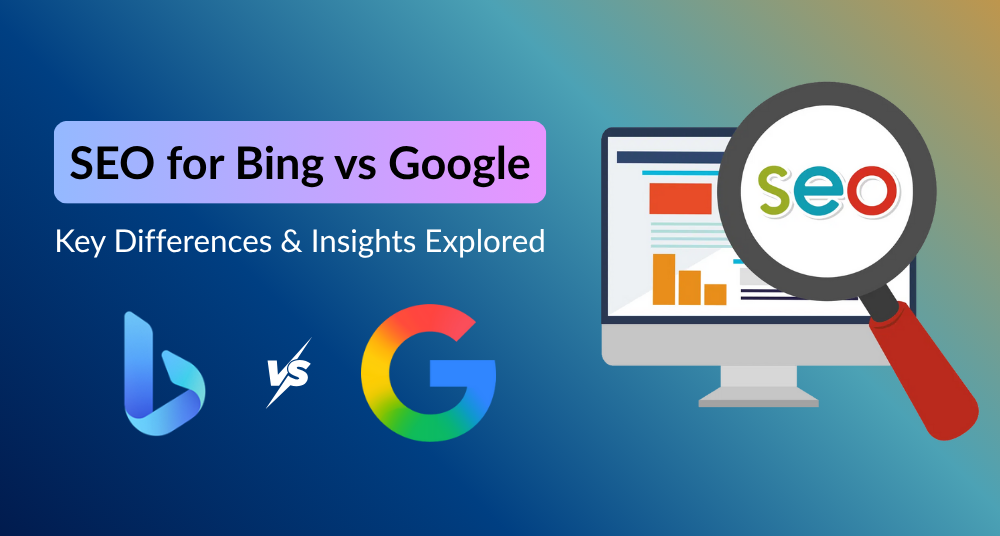In today’s digital marketing landscape, search engine optimization (SEO) remains a critical driver of organic traffic. While Google dominates the global search market, Bing continues to hold a significant user base, particularly in the United States and enterprise environments. Understanding the differences between SEO for Bing vs Google is essential for marketers aiming to optimize their online presence across platforms.
This case study explores the key differences, current trends, and best practices for optimizing websites on Bing and Google in 2025.
Market Share and User Demographics
Google accounts for approximately 90.06% of global search traffic, making it the primary focus for most SEO campaigns. Its users are diverse, tech-savvy, and span all demographics.
Bing, on the other hand, holds around 4.31% of global search traffic but sees higher engagement in desktop searches, enterprise environments, and Windows-integrated devices. For example, users on Microsoft Edge or Windows 10 often default to Bing, creating a valuable audience for certain niches.
Trend Insight: While Bing’s traffic volume is smaller, its conversion rates can be higher in targeted industries like technology, B2B, and finance.
Algorithm Differences: SEO for Bing vs Google
Google’s algorithm emphasizes:
- Content quality and relevance (E-A-T: Expertise, Authority, Trust)
- Mobile-first indexing
- Page experience and Core Web Vitals
- AI-generated content analysis
Bing’s algorithm, while similar in some respects, focuses more on:
- Exact keyword matches and on-page SEO
- Backlinks with domain authority
- Social signals integration (Twitter, LinkedIn)
- Multimedia content relevance (images, videos)
SEO Trend 2025: Bing increasingly incorporates AI-based content evaluation and semantic search, narrowing the gap with Google in understanding user intent.
On-Page SEO: Key Considerations
- Prioritizes user intent and semantic relevance.
- Encourages long-form content that thoroughly answers queries.
- Uses structured data (Schema.org) to enhance rich snippets.
Bing
- Gives more weight to exact keyword usage in titles, headers, and meta tags.
- Values high-quality multimedia and properly tagged images/videos.
- Social signals, such as shares and engagement, impact rankings more noticeably.
Case Insight: Websites optimized for long-tail keywords with multimedia integration tend to perform better on Bing, whereas Google rewards content that matches search intent and provides depth.
Technical SEO Differences
| Factor | Google SEO | Bing SEO |
| Site Speed | Core Web Vitals heavily impact ranking | Important, but less critical than Google |
| HTTPS | Mandatory for trust | Recommended, but not strictly ranking factor |
| Mobile Optimization | Mobile-first indexing is essential | Mobile-friendly design is important but desktop-first traffic remains strong |
| Crawl & Indexing | Frequent crawling and indexing | Slower indexing, prefers stable sitemaps |
Trend Insight: Bing still favors desktop-friendly, technically clean websites. Combining Google’s mobile-first optimization with Bing’s desktop readiness provides a dual advantage.
Link Building & Backlinks
- Emphasizes high-quality, authoritative backlinks from trusted domains.
- Penalizes manipulative or spammy link-building tactics.
Bing
- Values older, established domains more than Google.
- Backlinks from social media and niche blogs carry additional weight.
Trend 2025: Successful SEO campaigns target a diverse backlink profile, ensuring both Google’s authority-based ranking and Bing’s domain-age and social-signal preferences are met.
Content Strategy: Multimedia & AI
Bing has shown a greater affinity for rich media content than Google, making videos, images, and infographics more effective for ranking. In 2025, AI-driven content tools are influencing both platforms, helping marketers generate:
- Optimized content for multiple search intents
- AI-assisted metadata, alt text, and schema
- Predictive content suggestions for emerging queries
Case Study Insight: A tech blog that added AI-generated infographics and video summaries saw a 20% traffic increase on Bing, while Google traffic increased by 12% due to improved content depth.
Paid Integration: SEO Meets SEM
While SEO drives organic traffic, integrating Bing Ads and Google Ads enhances visibility. Key differences:
- Bing Ads: Lower CPC, strong in B2B, integration with LinkedIn audience targeting
- Google Ads: Larger reach, high competition, broader demographic targeting
Trend Insight 2025: Companies combining SEO insights with SEM campaigns on both platforms achieve better ROI and coverage.
Tools & Analytics
- Google Analytics 4 (GA4) for traffic, conversions, and user behavior
- Google Search Console for indexing and performance insights
Bing
- Bing Webmaster Tools provides keyword research, crawl stats, and SEO reports
- Integration with Microsoft Clarity allows heatmaps and user interaction analysis
Actionable Tip: Cross-analyzing Bing and Google data can uncover untapped keywords and traffic sources.
Comparative Case Study: Real Results
Scenario: A SaaS company optimized a blog for both Google and Bing:
- Google: Focused on long-form content, semantic keywords, and schema markup
- Bing: Added multimedia, exact-match keywords, and optimized social sharing
Results (3 months):
- Organic traffic: +35% Google, +28% Bing
- Conversions: +18% from Bing due to targeted desktop users
- ROI: Combined SEO & SEM strategy increased leads by 25%
Insight: Tailoring SEO to platform-specific algorithms maximizes overall traffic and conversions.
Key Takeaways
- Google SEO: Prioritize user intent, long-form content, and mobile optimization.
- Bing SEO: Focus on multimedia, exact keywords, social signals, and desktop performance.
- AI & Content Tools: Leverage AI for metadata, content suggestions, and multimedia optimization.
- Integrated Strategy: Combine SEO with SEM for better visibility, conversions, and ROI.
- Cross-Platform Analytics: Use insights from both platforms to discover untapped opportunities.
Trend 2025: AI and multimedia content are increasingly essential for both Bing and Google. Marketers who understand platform-specific nuances and adopt an integrated strategy are most likely to succeed.
Conclusion
While Google remains the dominant search engine, Bing offers unique opportunities, especially for desktop users, enterprise niches, and AI-optimized content. By understanding the differences in algorithms, ranking factors, and user behavior, businesses can craft a dual SEO strategy that maximizes reach, conversions, and ROI.
Adapting to platform-specific SEO trends, leveraging AI tools, and integrating organic and paid search strategies ensures that your business stays ahead in the competitive digital landscape of 2025.






What do you think?
It is nice to know your opinion. Leave a comment.